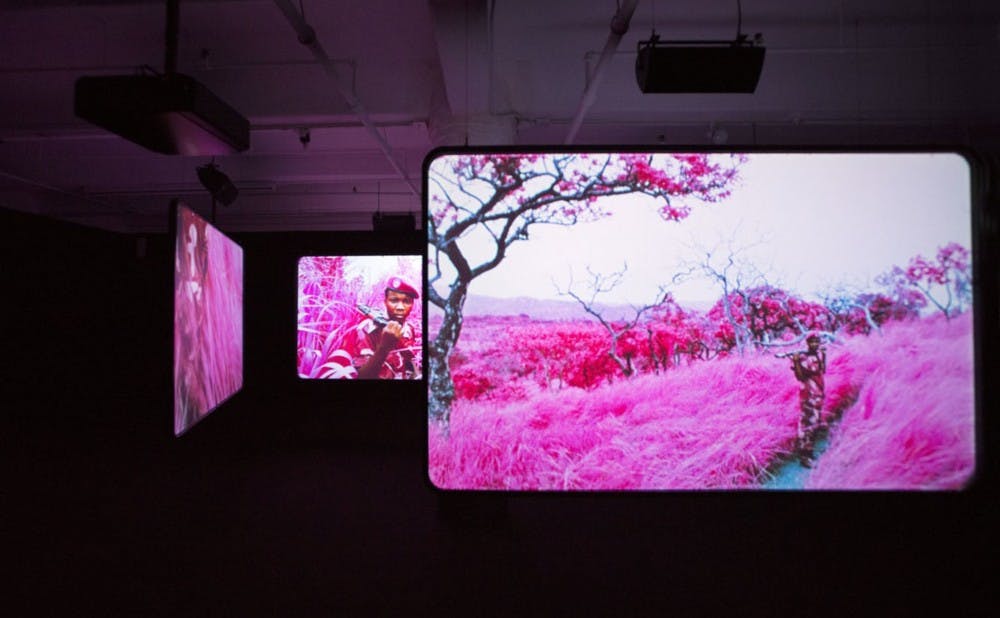Flipping through the channels on television, it seems that the an overwhelming amount of content has to do with war. War, while truly horrific at its core, can appear to be just as commonplace and normal as a commercial for Viagra. However, the horrifying nature of war hasn’t changed. Society’s sensitivity towards the graphic brutality of war has been suppressed by war’s prevalence in media. Richard Mosse’s “The Enclave” explores this jaded attitude toward war images by using the film as a medium to capture war in the Congo with an artistic twist.
In the back right pavilion of the Nasher, Mosse’s piece is set up in a dark room where six screens have been deliberately placed around the room. Each screen shows a different sequence and cut of Mosse’s video of war in the Congo. The piece in its entirety lasts 40 minutes. At first glance, what immediately stands out is that the landscape of the Congo is unabashedly pink and red.
“This particular film was shot with infrared technology used for camouflage detection from World War Two... finding Vietcong in the bush during the Vietnam War... and in practical applications in the study of landscapes such as glaciology, cartology... basically anything with -ology,” Mosse said during a presentation at the Nasher. “But it was also appropriated by popular culture [for album covers]... for those [artists] who were protesting against the war.”
As a result, Mosse takes this anachronistic technology designed for war and uses it to document a completely different wartime circumstance. Mosse described the conflict as being partially driven by the civil violence between the Hutu and Tutsi ethnic groups in parts of the country. Mosse followed a group of Congolese rebel fighters through their journey in which the ardent green becomes transformed into a fervent pink.
It was this raw, psychedelic video footage that captured the attention of Nasher curators Sarah Schroth, the Nasher’s Mary D.B.T. and James H. Semans director and Marshall Price, curator of modern and contemporary art, in a visit at the Venice Biennale in 2013.
“We had known of his large scale photographs... at many large scale art shows. But, this video medium really captivated the Nasher curators because it was so powerful in the way that it was presented on six channels,” said Wendy Hower, director of engagement and marketing for the Nasher.
What was also enamoring for Nasher curators about this work wasn’t just the raw depiction of war but it was how its uses of color, cinematography, and display transformed what can be a typical war scene into a jarring and empathetic experience.
Hower noted that though many of Mosse’s infrared landscape photographs could be misconstrued as a “fairy wonderland,” “The Enclave” is gripping because it shows clear evidence of the tragedies of war and how it affected the Congolese people.
“The way the film is shot with a steady cam sweeps me away into the film. The pink and magenta colors are so creepy, dark, and beautiful that I just can’t keep my eyes off of the film,” Hower said. “The juxtaposition of this fairyland landscape with this brutal war zone is just so moving...and you truly understand the context [of the Congo].”
“The Enclave” is different than most other video exhibits the Nasher has brought to the museum, Hower said. What really sets it apart from the previous exhibits is the multi-channel system that graces the entire pavilion.
Additionally, the positioning of the screens in the display allows the audience to design their own viewing experience. One can step back and view the piece as an amalgam, or step inside the maze of screens and have three different screens each projecting the violence three distinct ways. In this way, the final piece is able to resonate more naturally with the audience and immerse them into the conflict itself.
“There’s no one way to view the piece,” Mosse said. “Right when you’ve got yourself in a position that you think you can see all the screens, one of them might go dark, and you have to move to get a different perspective.”
“The Enclave” serves as a sensitizing influence between our own comparatively comfortable world and a war torn world to which many may be numb. Entering the dark pavilion, the viewer is left only to face the screens. There is nothing else to distract the viewer except for the shocking imagery and dissonant content.
“The subject matter is not common. We don’t talk about the Congo [at Duke] except for maybe a class,” Hower said. “Students should come to the exhibition because the subject matter is worth learning about—it is so extreme and relevant.”
Towards the end of Mosse’s lecture, an audience member asked why he chose to film in a way that emphasized the pink and red hues of the landscape. Mosse’s reply was that for an artist to reveal the meaning of a piece is frowned upon, but in any case, to him the pink literally shows where there is rich and verdant life and hope for this war torn region. “The Enclave” in a sense is hope for us to empathize with people distant from us, yet similar, human and deserving of dignity.
The Enclave is now on display at The Nasher until Jan. 10.
Get The Chronicle straight to your inbox
Signup for our weekly newsletter. Cancel at any time.

